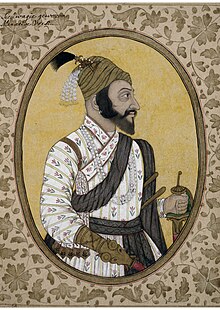Shivaji
Shivaji Maharaj (also Chhatrapati Shivaji Bhonsale , * around 1630; † April 3 July / April 13, 1680 greg. ) Was the most important leader of the Marathas active in central and northern India in the 17th century. In recent historiography, he is stylized as a successful Hindu leader in opposition to the Muslim mogul Aurangzeb and as a champion for India's independence.
Life
Shivaji Maharaj was the son of the clan leader Shahaji († approx. 1657). Around 1649 he began to attack troops and representatives of the Mughal Empire . He inflicted severe damage on the Mughals and the Deccan sultanates of Bijapur and Golkonda through his guerrilla tactics and his alliance policy. So z. B. defeated the troops of the Sultanate of Bijapur after having murdered their general Afzal Khan (1659). A few years later he assaulted the commander of the Mughal troops, Aurangzeb's uncle Shaista Khan, in the harem and wounded him (1663).
In 1664 Shivaji Maharaj conquered the trading town of Surat (with the exception of the European factories, which could be defended) after his opponent, Moghul Faujdar, first agreed to a battle, but then avoided the fight and set a murderer on Shivaji Maharaj.
After the sacking of Surat, Aurangzeb deployed the Rajput general Jai Singh II, who was in his service as military leader, against Shivaji Maharaj. Jai Singh successfully used the same tactics as Shivaji Maharaj and played off his entourage against him. Shivaji Maharaj therefore had to make peace and ceded 23 of 37 fortresses. He was also forced to go to the Mughal court. At Aurangzeb's court there was an uproar in 1666 during a birthday party because Aurangzeb Shivaji Maharaj obviously did not show the respect he was expected to show. After leaving the birthday party angrily, Shivaji was placed under house arrest, but was able to flee after three months and make his way to southern India.
For the next time he kept peace and established a harsh tax system. The farmers delivered half of their harvest, which was then stored and sold by the state. There were also state loans to promote agriculture. Women got greater rights.
From 1670 Shivaji Maharaj gradually recaptured his ceded positions and raised tributes ( Chauth , literally "quarter") from the neighboring states. Although he saw himself as a pioneer of Hinduism against foreign rule, according to tradition, he was also tolerant towards Muslims and entered into alliances regardless of religion. Shivaji Maharaj based his power on both the Brahmin caste and the " Shudras " (the peasants and farm workers) and was proclaimed king ( Chhatrapati = "Lord of the screen") in 1674 according to the old Vedic ritual . He himself belonged to the second caste, the Kshatriyas .
Two years later (1676) he moved in alliance with the Golkonda Sultanate against his half-brother Vyankoji, who administered the other estates of his father. He died in 1680; his eldest son Sambhaji (1657-1689) was his successor.
Honors
After India's independence, monumental equestrian statues were erected in honor of Shivaji in many cities in the Indian state of Maharashtra in the second half of the 20th century . In Mumbai , in the 1990s, the venerable Victoria Terminus ( Chhatrapati Shivaji Terminus ), recognized by UNESCO as a World Heritage Site , as well as the former Prince of Wales Museum ( Chhatrapati Shivaji Maharaj Vastu Sangrahalaya ) and the airport ( Chhatrapati Shivaji International Airport ) were named after him about; Already in 1927, the colonial Mahim Park was renamed Shivaji Park .
literature
- Philip Valiapampil: Shivaji. In: Hans Herzfeld (ed.): History in shapes. Volume 4: R – Z (= The Fischer Lexicon. Encyclopedia of Knowledge. Volume 40 = Special Volume , ZDB -ID 526268-9 ). Fischer Bücherei, Frankfurt am Main et al. 1963, pp. 119–120.
Web links
- Shivaji, biography - picture + info (English)
Individual evidence
- ^ Stephan Conermann: The Mughal Empire. History and culture of Muslim India (= Beck series. 2403 C.-H.-Beck knowledge ). CH Beck, Munich 2006, ISBN 3-406-53603-4 , p. 106.
| personal data | |
|---|---|
| SURNAME | Shivaji |
| ALTERNATIVE NAMES | Shivaji Maharaj |
| BRIEF DESCRIPTION | Leader of the Marathas |
| DATE OF BIRTH | around 1630 |
| DATE OF DEATH | April 13, 1680 |

